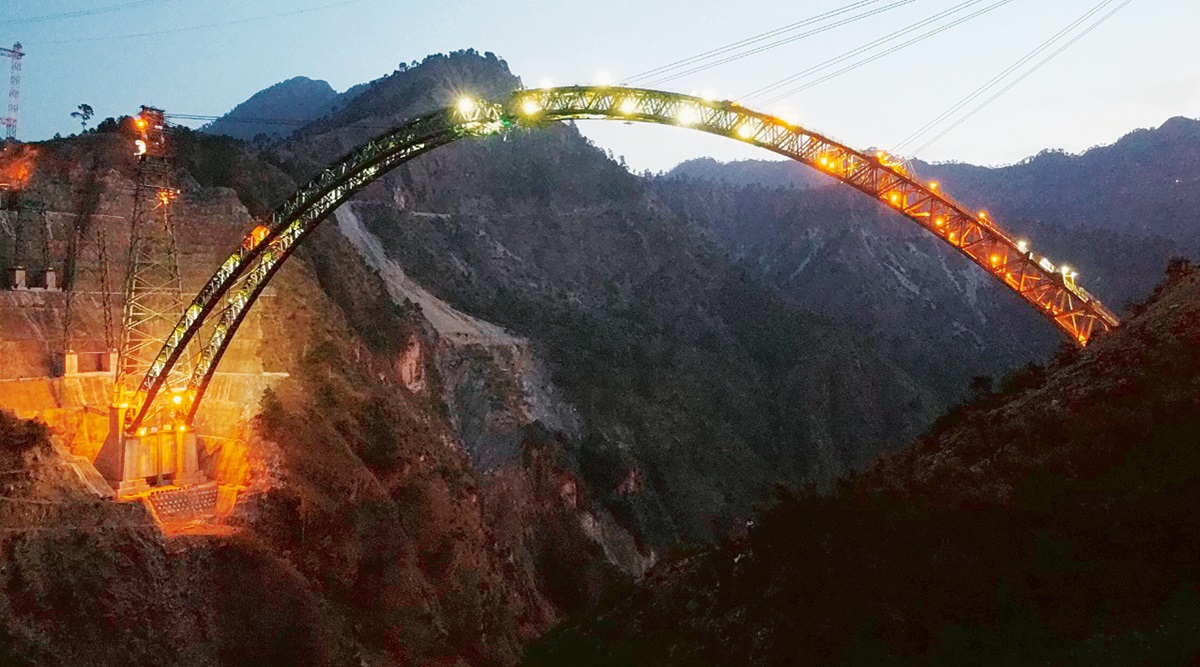
A HALF KILOMETER long arch, the defining feature of the world’s tallest railway bridge over the Chenab River, will be completed on Monday. And with this, the greatest civil engineering challenge facing any railway project in India in recent history will be completed.
The last 5.3 meter metal piece will be placed at the highest point on Monday and will link the two arms of the arch that currently extend towards each other from both banks of the river. This will complete the shape of the arch that will then rise above the treacherous Chenab, flowing 359 meters lower.
The arch, the most difficult part of the Rs 1,400 crore bridge over Chenab, is a huge leap towards the completion of the 111 km long and winding stretch from Katra to Banihal. It will symbolize the Kashmir railway link, which will be ready for at least a century. In other words, a train from Kanyakumari can reach Kashmir without interruption.
At present, the Kashmir link means a 25 km stretch from Udhampur to Katra, an 18 km stretch from Banihal to Qazigund in the Valley and then the 118 km Qazigund to Baramulla line. All of these have been operational for years. The only piece missing from the link is the Katra-Banihal stretch, and the bridge over Chenab was the main engineering hurdle that impeded progress all these years.
The cable crane that will do the job of completing the arch itself measures around 900 meters, and is said to be the longest in the world, made especially for this project.
“Up there, the winds are so strong that we have to stop work several times and resume only when the wind calms down and the weather is suitable,” said Vijay Sharma, director of the Udhampur-Srinagar-Baramulla National Rail Link (USBRL). Project in Jammu and Kashmir, the Northern Railway arm that is executing the work.
By the time the winds reach 50-60 km per hour, the work stops. And so it has been for the last two and a half years that it has taken the arc to complete.
The Chenab Bridge has been mired in controversy since its inception because it is smack in the middle of Seismic Zone IV and nestled in the young, folding Himalayas, making it a difficult call for railway engineers. A railway bridge like this, with this kind of geography, has not been made anywhere in the world, according to the Railways. There is also a much smaller Anji bridge before Chenab, but that cable-stayed bridge is nothing compared to this work, the engineers said.
With the arch complete, it is now possible to estimate when the entire project will be completed. So now the much touted Chenab Bridge is scheduled to be completed by this time next year, a few days or so. “From an erection or structural point of view, the arch was the main and most difficult element of the entire bridge construction. Now, the remaining work, such as the laying of the platform and the rest will be done during the next 12 months, ”he said.
For the past two and a half years, engineers have been building the arch with the help of two gigantic cable cranes installed on both banks of the Chenab: the Kauri End and the Bakkal End.
The biggest challenge was that the 550 meter arch, weighing 10,000 metric tons, had to be supported only with the support of the two embankments and without any intermediate pier, as the river is 359 meters below and no pier could reach at a height like the river. that. From “support to support”, the distance is 467 meters. The entire bridge is going to weigh about 29,000 metric tons. Engineers began working from both embankments simultaneously, beginning with the installation of the cranes that would launch the arch.
Each specially designed cable crane, installed on the two banks by Afcons, is about a kilometer long. The two cranes have been working independently and also synchronously, from each bench and joining pieces of the arch little by little.
And for parts handling, a nationally accredited welding workshop and laboratory was erected on the construction site, to speed up the work, a first for a project in India. Steel parts are cut by computerized machines, then tested to the standard before authorizing implementation.
The total length of all the handling done for the bow, if added, is around 550 km, “almost the distance between Delhi and Jammu,” Sharma said.
Rains, thunderstorms, landslides and even snowfall, have stopped working regularly. They still do it. A lot of precision craftsmanship is also required because the workers must scale the heights with safety equipment and perform the various jobs. Along with the engineering challenge, the challenges posed by the weather were the biggest hurdle, said Vishwa Murthy, Project Manager for Afcons Infrastructure, which is executing the work for Railways.
“We have started working at 5 in the morning every day to continue until late at night, sometimes extending into extended hours as well. Once the arch is finished, the dismantling of the cables, which now support the structure, will take about a month, ”he said.
And then there was COVID-19 for the last year.
The railroads, with special help from the J&K government, have now vaccinated the 680 workers, officers and engineers at the Chenab site for free. Every new one who enters the camp is isolated and tested before entering.
By Monday afternoon, the 5.3-meter piece of metal, hanging from one end of a crane, will be slowly placed on top of the arch. First there will be a firm tightening, then a torque machine will tighten it more to a preset value, and finally the bolt is rotated 90 degrees more until it reaches its maximum strength as designed.
.